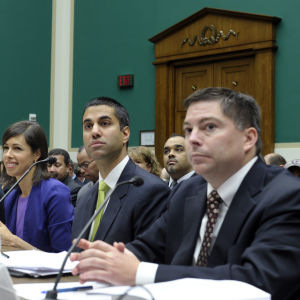For the first time in history the Federal Communications Commission bypassed a commission vote and released its annual report on competition in the video marketplace Friday — a move Republicans said was intended to avoid scrutiny of new rules the agency is developing for traditional video providers.
The agency’s Media Bureau dropped the 17th annual report Friday, a departure from the 16 prior reports all voted on by commissioners before release.
Republican FCC Commissioners Ajit Pai and Michael O’Rielly described the move as typical Friday Washington politics, when agencies purposefully time releases to get little notice before the weekend.
“Who’s afraid of a commission vote?” the commissioners said in statement late Friday. “Charged by Congress in 1992 with the duty to provide an annual report on the status of competition in the market for the delivery of video programming, the commission today, for the first time, punts this responsibility to the Media Bureau instead of bringing the proposed report to the commissioners for a vote, as has occurred 16 times in the past.”
The report comprised of data from 2013 to 2014 found the second decline in a row in cable video subscriptions, a trend that has only occurred the last two years in all 17 years of reports.
Mutichannel video programming distributor (MVPDs) subscribers fell from 101.7 million households to 101.6 million, with cable specifically falling from 55.1 million to 53.7 million. Telephone MVPD subscriptions rose 11.8 million in 2013 to 13.2 million households, with satellite video subscriptions holding steady at 34.4 million.
Despite the decline the FCC reported increased revenues in the cable market, up 1.3 percent from $61.5 billion in 2013 to $62.3 billion in 2014 as a result of providers “raising the prices charged for video services.” Satellite provider revenue rose 5.2 percent from $38.6 billion to $40.6 billion.
Though prices did go up, they failed to keep pace with programming costs, according to the report, which found “the average video profit margin for the three largest cable MVPDs (by subscribers) fell from 19.2 percent to 17.3 percent” in 2014.
The report found the online video industry, represented by streaming services like Netflix, Amazon and Hulu, continue to bring more competition to the marketplace, “expanding the amount of video content available to consumers through original programming and new licensing agreements with traditional content creators.”
“Some OVDs [online video distributors], like Netflix, have invested in their own servers, content delivery networks, and other infrastructure to facilitate the delivery of video programming to consumers,” the report reads. “Technology companies like Amazon, Apple, and Google continue to deliver solutions that include Internet infrastructure, software, devices, and video programming.”
In 2014, 90.9 million U.S. households with high-speed data connections used an average of 7.3 Internet-connected devices, including gaming consoles, media streaming devices, Internet-connected TVs and Blu-ray players, tablets, and home computers. Several OVDs reported video content growing hand-in-hand with consumers’ use of mobile devices.
The findings come as the agency mulls new regulations that would compel cable providers to make their programming available on third-party set-top boxes, giving consumers a choice to buy a box from a company like Google instead of renting them monthly from cable providers like Comcast or Verizon.
According to a congressional survey cited by the FCC as justification for the proposed rules, the set-top box lease market nets cable providers almost $20 billion annually through set-top box leases, and cost the average U.S. consumer $231 per year.
“Our goal should not be to unlock the box; it should be to eliminate the box,” Pai said during the FCC’s February open meeting, where the rules were advanced. “If you are a cable customer and you don’t want to have a set-top box, you shouldn’t be required to have one. This goal is technically feasible, and it reflects most consumers’ preferences — including my own.”
Pai and O’Rielly argue the market isn’t in need of FCC intervention, since the growing adoption of apps and streaming services — described in the agency’s own report — is already creating competition in the market.
“Perhaps we shouldn’t be surprised by this move to sneak out the door on a Friday afternoon 117 pages of rationalizations for the commission’s various ill-advised attempts to micromanage a market that is objectively more vibrant and competitive than at any time in history,” Pai and O’Rielly said Friday.
“After all,” they continued, “the last two Wireless Competition Reports met the same fate. It’s bad enough that our input on circulated and meeting items is typically ignored, but this disturbing trend of skipping the Eighth Floor entirely must be reversed, and is worthy of Congressional attention.”

